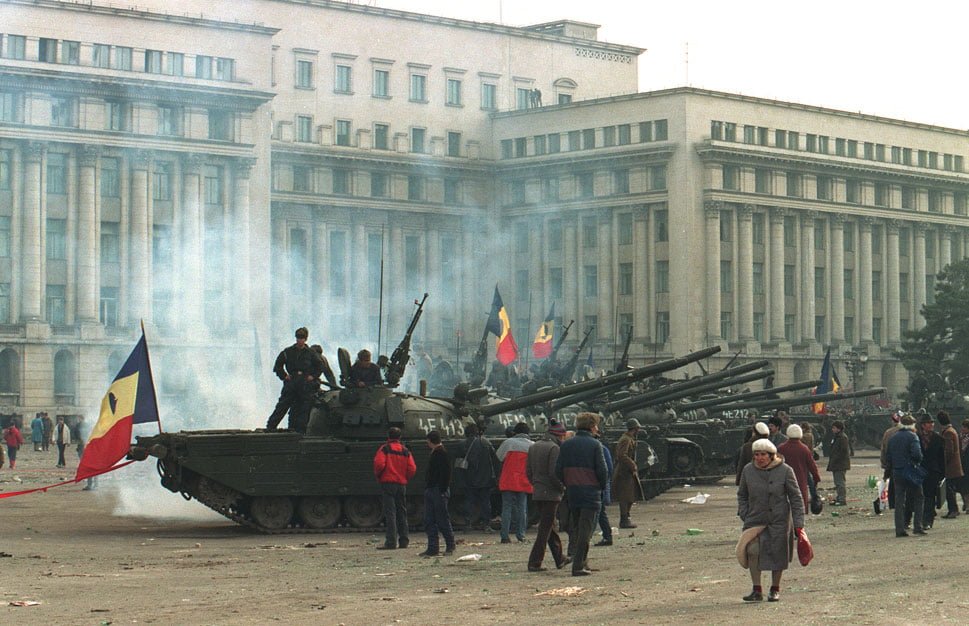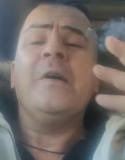What I Saw in the Romanian Revolution (Chapter 1)
Part 1 of a multi-part series on the 1989 Romanian Revolution in Bucharest and aftermath, including my experiences.
I.
A DARK PLACE
The first thing you notice is the darkness.
Romania was a dark place in 1989. Streetlights shut off at night. Homes were kept in darkness. The one and only state-run television station broadcast just a few hours a day. Light bulbs were limited to 25-watts. Families turned on gas stoves to stay warm at night because there wasn’t any heat. The streets were completely deserted in the evening. Bucharest — Romania’s capital city of 2 million — choked on the poison of diesel fumes and coal dust inciting the ghostly gray haze hanging over the city like an intransigent fog.
And yet for all its bleakness, this was the least of Romania’s problems.
Staring out the window of a silent and nearly empty Lufthansa Airlines flight which had taken off two hours earlier from Frankfurt and was now headed to Bucharest gave me sufficient pause to realize, for the first time, that I’d be stepping out of one world into another. I’d soon be trading an easy and familiar life for an experience sure to be far more challenging and lesser-known. Leaving what was once called “the free world” to live and work behind the ominous Iron Curtain was the closest thing imaginable, I suppose, to time travel.
Indeed, flying into Bucharest that night was like going back in time.
Of all the old hard-line Communist regimes, aside from Enver Hoxha’s diabolical rule and the subsequent fallout years afterward in Albania, Romania’s situation was the most repressive and dire. Romania’s longtime ruler, Nicolae Ceausescu had been on the cover of Newsweek magazine weeks earlier, the headline fitly labeling him “The Last Stalinist.”
This dark place was to be my home for the next two years.
II.
“PUNCH”
Alan Green had just been picked as the new United States Ambassador to Romania. Amb. Green preferred to be called “Punch,” a most fitting nickname given his lively spirit and wonderful sense of humor.
Punch Green was close to 70 at the time, much older than the typical first-time ambassadorial pick. He’d been a longtime Republican Party activist and fundraiser from Portland, Oregon who made his fortune in the paper manufacturing business. Punch Green chaired the presidential campaigns of former Presidents Gerald Ford, Ronald Reagan, and George Bush, Sr. in Oregon. As a trade-off for his unwavering loyalty, Punch Green was awarded the ambassadorship to Romania in 1989.
Romania wasn’t exactly the kind of “reward” one might expect as a payback. The cushy political appointments within the foreign service usually meant getting assigned to garden-spot places like Luxemburg, Malta, Denmark, Portugal, or some other easy country where most workdays consisted of shaking hands, marching in parades, and attending tea parties. Such appointments were little more than extended vacations for those bestowed, only with an impressive title to accompany the tour. Instead, Punch Green was assigned to one of Eastern Europe’s harshest political assignments during a turbulent time when the entire region was about to undergo a revolution. That same year, Communist regimes in Czechoslovakia, Poland, and Hungary would fall. The Berlin Wall would also come down.
Punch Green was a controversial appointment. Like with most federal government agencies, the State Department was internally divided on so-called “political appointees.” Rank and file State Department employees, especially veteran foreign service officers (FSO’s) mostly loathed political appointees like Green. They were viewed as two-bit election hacks who were given assignments, not because they knew anything whatsoever about diplomacy or the nation where they’d be assigned, but simply because they’d worked on the winning campaign and backed the right candidate. Political appointees like Punch Green were viewed as human barriers to legitimate career diplomats who had worked their way through the ranks and up the chain of command, but who were bypassed in favor of someone else whose qualifications for the job consisted of raising lots of campaign money or helping the President carry a key state.
Punch Green did both. And he was sitting one airplane row in front of me on that Frankfurt to Bucharest flight.
This was pure coincidence. I certainly didn’t merit flying in with the U.S. Ambassador to Romania. After all, this was my first foreign post. Punch Green didn’t know me or my name from Nicolae Ceausescu.
I suppose Punch Green eventually recognized that I wasn’t a Romanian. So, he asked to borrow an American newspaper I’d brought along. Indeed, he didn’t recognize me, nor did he have reason to. But I knew him. In fact, I’d attended his swearing-in ceremony a few months earlier in the Treaty Rooms on the Seventh Floor at Main State. Punch Green was sworn in by Supreme Court Justice Sandra Day O’Connor (now retired), which made quite an impression on this 27-year-old on his first government assignment.
That flight was a surreal experience. The new American Ambassador sat a few feet away. Here we were together on a nearly empty flight, except for a few dozing diplomats scattered amidst the dimly-lit cabin.
The wheels touched down. My new life was about to begin.
III.
PARANOIA
There is dark. Then, there is darkness without hope.
There’s a difference. Darkness without hope is far more depressing.
You see it in their faces. In their eyes. In the way, they walk and talk. In the way, they behave and do everyday things.
Romania was a nation starving for antidepressants. Any stimulant to bring a moment of joy. Anything to bring hope. Anything to bring light.
But instead, there was only darkness, hopelessness, and above all else — fear.
The fear. Everywhere.
It’s impossible to comprehend the paralyzing fear which is stoked by decades of repression unless you’ve lived inside a totalitarian state. A place where neighbors spy on neighbors. A place where everything you say or write is potentially scrutinized and perhaps even recorded. In its heyday, Romania reportedly had ten million microphones hidden inside walls and attached to communication devices, sure to be dissected by the effervescent eyes and ears of Securitate, the dreaded state security service that was said to have half-a-million employees and informers in a nation of 23 million.
It wasn’t paranoia knowing that all phones were tapped, even those of diplomats. In fact, foreigners were the most likely to be watched and followed. My apartment walls were riddled with tiny holes, some of which surely contained hidden microphones. Trouble was, there were so many of them, there was no way to debug the house. You just got used to living with constant surveillance. [SEE FOOTNOTE]
Ordinary Romanians you came into contact with were almost always agents of Securitate or paid informers. I would later discover my housekeeper — who oddly enough spoke flawless English — was on their payroll and filed daily reports of my activities (and personal belongings). Even the American Embassy on Strada Tudor Arghazi couldn’t hide from the cameras and microphones. Giant sound dishes were installed across the street and were aimed at every room within the Embassy compound. The sound dishes were so strong they could pick up conversations (actually sound waves) through walls and windows.
Towering over the American Embassy in Central Bucharest was the Intercontinental Hotel, then a joint venture between a Western hotel chain and the Romanian Government. At 30 stories, this was the tallest building in the city. As a trade-off, the Intercontinental Hotel’s entire top floor was left vacant and padlocked to visitors. Yet its windows were always wide open. Powerful video cameras and lenses stuck out of those windows at all times, their eyes watching every move within the Embassy compound.
Yet for all the annoyances of being watched, followed, and listened to — things were much more dangerous for Romanians. Embassy staff was protected by diplomatic immunity. After a while, one simply got used to the idea that everything you did would end up in a typed report stuck in a file cabinet somewhere by some bored civil servant. Indeed, for Romanians saying or doing something deemed as dangerous to the state could trigger an arrest, or much worse.
IV.
BEFORE CEAUSESCU
Things weren’t always this way.
Once called “the Little Paris” and “the Paris of the East,” Bucharest was once a colorfully happy place with an abundance of art and culture.
Even during the darkest times on the coldest days, the realization of past hopes and dreams was everywhere — in the stone buildings and ornate architecture, in the delicious food and wine, in the beautiful language, and in the sad but friendly people rightfully proud of being Romanians despite what their nation’s despotic leader had done to bastardize such a rich heritage.
Romania is a Latin island surrounded by a sea of Slavic nations and peoples. Originally colonized by the Romans, ancient Dacia (what’s now modern-day Romania) closely resembles what one would expect to see in Italy, France, or Spain. Indeed, the nation was named in honor of the Romans and retains cultural ties much more aligned to the West than its neighbors — Serbia, Bulgaria, Moldova, and Hungary.
Arguably, Romania’s most famous historical figure is the ruler who was later immortalized as “Dracula.” Vlad Tepes, a.k.a. Vlad the Impaler ruled Transylvania during the 15th Century. He acquired his monstrous reputation for what was actually a brilliant military strategy.
At the time, the world’s premier political and military power was the Ottoman Empire. The Turks invaded Europe, including the mountainous region of central Romania known as Transylvania. Vlad Tepes and the Romanians were hopelessly outnumbered and couldn’t possibly match the military strength of the Turks. So, Vlad Tepes devised a formidable counter-strategy. In what can best be described as one of the earliest uses of state-sponsored terror, Vlad Tepes impaled thousands of enemy soldiers who had previously been captured in battle. The mutilated bodies of dead Turks were displayed in fields on giant stick-like poles. When Turkish forces later invaded the territory, they saw a terrible fate that awaited them if captured. As a result, many parts of Romania were by-passed and remained free of Ottoman rule.
Today, Vlad Tepes is considered by many Romanians to be a national hero. He may be “Dracula” to many of us. But he was also a patriot and leader to the Romanian people at a critical time during their history.
Unfortunately, Romania hasn’t always been on the right side of history. Due in large part to its close cultural affinity with Italy and repudiation of all things Russian, Romania joined with the Axis powers during World War II. It was even allied with Nazi Germany and helped to supply the Wehrmacht with necessary fuel while it blitzkrieged all across Europe and North Africa — the oil plentifully provided by the Ploiesti oil fields, located just north of Bucharest.
Following the second world war, Romania was essentially thrown to the wolves by the West. At the Yalta Conference, it was agreed that all of Eastern Europe would be classified as part of the Soviet Union’s “sphere of influence.” Hence, Communist puppet governments were propped up all over Eastern Europe, including Romania.
Oddly enough, Nicolae Ceausescu — who came to power in 1968 as General Secretary of the Romanian Communist Party — was one of the first Eastern-Bloc dictators to successfully break away from Soviet domination (others tried but were killed — as in East Germany in 1953, Hungary in 1956, and Czechoslovakia in 1968)). By the time Ceausescu came to power, no Russian military forces were stationed within Romania During much of his rule between 1968-1989, he was considered a “maverick” Marxist. He was even well-liked in the West until the final decade of his dictatorship when things went terribly wrong within Romania and the revelations of his many crimes and human rights abuses began to leak out. [SEE FOOTNOTE ]
V.
ARRIVAL — BUCHAREST OTEPENI AIRPORT (1989)
There’s a funny line from an old movie called Love at First Bite with actor George Hamilton playing the role of a vampire.
Dracula is living in somewhere Romania All the local townsfolk finally get fed up with the count’s crazy antics. So, they conspire to get rid of Dracula. Hamilton becomes incensed about this and screams, “What are you all going to do for excitement without me around here? It’s going to be as boring as Bucharest on a Monday night.”
I arrived in Bucharest on a Monday night.
The Ambassador made it through customs in about two minutes. Go figure. It took me more than two hours. Paperwork. Body searches. I suspect this was all a tactic to let newcomers know who exactly was going to be in control from this point forward. Of course, Ambassadors didn’t have to worry about such indignities. But a low-level first-timer out of the country was sure to be tested early.
Romanians were forbidden from accepting Western currency. So, everything was bartered in cigarettes. And I mean — everything.
A proper tip for a porter was a pack. You’d tip a waiter a pack. A haircut costs two packs. Theater tickets, depending on the show, cost 3 or 4 packs. Getting your entire house cleaned three times a week by a housekeeper cost a cartoon (about $25 at the time). I bought an 8 x 10 handmade wool Romanian rug for three cartoons.
The brand of choice for Romanians was Kent.
Yet oddly enough, one rarely saw Romanians actually smoking Kent cigarettes. Sure, all Romanians smoked. But they opted for much cheaper (and inferior) Romanian or Turkish smokes. Packs of Kent were as good as American dollars or gold.
And so, my pockets and an entire suitcase were packed with Kents. I wondered what customs officials in the U.S. and Germany must have thought when they screened a huge bag containing 30 cartons of cigarettes. I suppose the real nature of their usefulness and value was well known to anyone who lived or worked in Eastern Europe at the time.
An American Embassy employee I’d never met before met me at the airport. He whisked me away in a VW Jetta, one of the few Western cars on the road. I was driven to what was to be my new residence — a luxury sixth-floor three-bedroom completely furnished apartment with all amenities overlooking the city of Bucharest. I even had my own garage space, a rarity in crowded Bucharest.
I was told to drop my bags at my place and then get back into the car. There was no time for rest.
Where exactly was I off to next, following a flight across Europe into the most bad-ass country in Eastern Europe?
Check back tomorrow for the answer, and lots more to come.
NOTE: This is the first chapter in a series of writings on my experiences during the Romanian Revolution of 1989. I’ll continue this narrative series as long as I remain interested in revisiting those historical events of 24 years ago.
SEE MORE: My previous post on this subject can be viewed here in “What I Saw — Photo Essay of the 1989 Romanian Revolution”
FOOTNOTE 1: Where do you suppose the Ceausescu regime obtained ten million tiny microphones? How about this. The United States. That’s right. Many of the microphones used by Securitate to spy on ordinary Romanian citizens were manufactured by Texas Instruments (TI), then a high-tech company based in Dallas. When Nicolae Ceausescu made his state visit to the United States in 1976, three cities were included on his itinerary — New York, Washington, and Dallas. Ceausescu even personally toured the manufacturing plant in Richardson, TX — as one of TI’s best foreign customers. So much for American corporations taking a moral high ground in the fight against Communism. For greater detail, read Ion Mihai Pacepa’s book “Red Horizons: Chronicles of a Communist Spy Chief” which is a first-hand account of the highest-ranking official ever to defect to the West and his observations while running the Romanian secret police.
FOOTNOTE 2: Nicolae Ceausescu’s 21-year rule in Romania is a fascinating case study of a political transformation. Born poor and largely uneducated, Ceausescu worked his way up from virtual peasant status through the ranks to the nation’s premiership. Often ridiculed (secretly, of course) by the urban bourgeois for a lifelong speech impediment and his frequent mispronunciation of words, Ceausescu always had a bit of an inferiority complex. This was undoubtedly fostered by a Napoleon complex (Ceausescu stood at 5′ 5″). He always insisted on being photographed standing on a platform or on a footing that gave him equal or greater height than those he was with. Ceausescu was widely considered to be (and would have likely been judged by history far differently) one of the first Communist reformers. He broke ranks from other Eastern European hardliners and created trading relationships with the West. However, Ceausescu’s state visit to North Korea in 1971 changed everything. Ceausescu saw an entire society completely molded and controlled by the state and its leader. Naturally, Ceausescu was only shown the most impressive displays of what remains one of the world’s most repressive nations to this day. Nonetheless, he returned to home intent to create a new version of Romania, using many of the same practices and policies of the monstrous Kim Il-sung in North Korea. That gradually became Romania’s downfall and his own demise.
SHORT VIDEO CLIP OF CEAUSESCU’S STATE VISIT TO NORTH KOREA (1971) BELOW:















Please continue this as I am fascinated by world events as viewed by the people who were there. I always had a different view as I was U.S. Air Force on flying status in C141 cargo jets. I have been a lot of places but only saw snapshots of what was there.
I read you blog every time you you post. I don’t always agree with you, but I do like the point of view.
Can’t wait to see where this is all going. Great writing as always Nolan
I visited Romania in 1973 with a tour that travelled by bus and stayed in campsites. We entered Romania from Russia, and compared to Russia in 1973, Romania was still the “Paris of the East”. That was fairly early in Ceausescu’s reign, but it still gives you an idea of how bleak things were in Russia then.
Nolan:
Not to put too fine of a point on it, but I’m pretty sure that video of Ceausescu’s visit to North Korea couldn’t have taken place in 1971 because I recognize some of the parade cars as Lincoln Town Cars from the mid 1970’s.
Amazing video, nonetheless.
Yes, upon close inspection those first two parade cars should be vintage 1975 Continentals/Town Cars at the earliest.
Pretty funny how Communist leaders would import American-made vehicles for these big events..
NOLAN REPLIES:
Thanks for posting.. Correction noted. I’m not sure if there was a second visit to North Korea, perhaps sometimes during the late 1970’s. I went by what was titled on the video. That said, it is ironic that the parade cars in North Korea are/were American-made.
— ND
Dear Nolan –
I just came across this series of pieces and they’ve blown me away. My vague recollections of the revolution are really only a couple of pictures I recall I seeing of palace guards being shot pretty much ad hoc in front of a building by random civilians (I guess) and Ceausescu and his wife (right?) lying there riddled with bullets and my thinking, “I feel nothing for them. How weird is that?”
Your writing is evocative, informative, and powerful. It is, to use one of the higher compliments I could give, Willis-esque. I feel both more intelligent and more connected to the world community after reading your work.
Regards, Lee